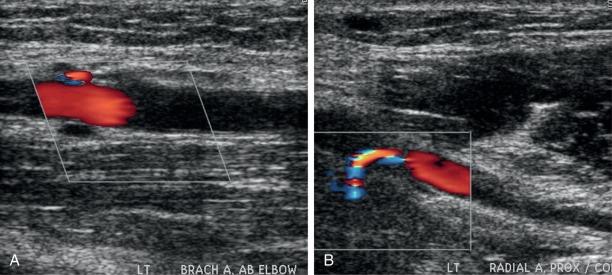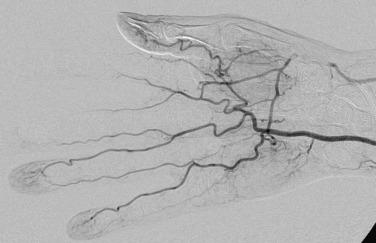Physical Address
304 North Cardinal St.
Dorchester Center, MA 02124
Nontraumatic, acute occlusion of arterial supply to a limb or organ presents with a constellation of symptoms specific to the tissue suddenly deprived of arterial perfusion. Irrespective of the arterial segment involved, this syndrome represents a vascular emergency. Irreversible organ injury may occur within seconds in the case of acute embolic occlusion of a middle cerebral artery or take hours when arterial supply of a lower limb is involved. In everyday clinical practice, acute arterial occlusion is synonymous with acute limb ischemia . Rapid recognition and treatment are required to prevent limb loss and life-threatening morbidity. Acute limb ischemia is thus defined as a sudden limb-threatening decrease in arterial perfusion of less than 14 days’ duration. It can occur as a result of embolic occlusion or in situ arterial thrombosis. Over the last several decades, the etiology of acute limb ischemia has varied with changing prevalence of causative conditions. The management of the syndrome has evolved, but the diagnostic skills required to recognize this clinical entity remain unchanged.
Acute limb ischemia is a rare vascular event and its incidence eludes exact quantification. It has been influenced by the ever-changing medical landscape. Increasing numbers of patients treated with antiplatelet and antithrombotic therapies, effective therapy for atrial fibrillation, and advances in treatment of valvular and ischemic heart disease have had an impact on the incidence of acute limb ischemia by decreasing the number of embolic events. This may be counterbalanced by increasing numbers of patients undergoing elective surgical and endovascular revascularization therapies, which carry a low but measurable risk of graft or stent thrombosis. An estimate in the 1990s proposed that a vascular center serving a community of 500,000 may expect an annual incidence of 75 patients with acute limb ischemia of the lower extremity. Other studies report similar data, estimating the incidence of acute lower limb ischemia between 13 and 17 cases per 100,000 people per year with mortality as high as 18%, even in the modern era. Contemporary studies report amputation rates as high as 13% in patients presenting with acute limb ischemia of the lower extremity. Retrospective analysis suggests that 1-year amputation-free survival in patients with acute limb ischemia who present to the emergency department at a tertiary care facility is 71%, with 8% of survivors suffering from permanent motor deficit in the involved limb.
Acute limb ischemia affects men and women equally. It is infrequent in patients with established peripheral artery disease (PAD), except in those who have undergone surgical or endovascular revascularization and developed acute thrombosis of the conduit, graft, or stent. Patients with symptomatic PAD who do not have atrial fibrillation develop acute limb ischemia at an annual rate of 1.3%. The majority (69%) of these events are due to graft or stent thrombosis, while in situ thrombosis is responsible for 27% of acute ischemic episodes. Acute limb ischemia is typically a disease of middle aged and older populations, but can affect younger patients when unusual clinical events such as paradoxical embolism, intracardiac masses, and endocarditis or hypercoagulable syndromes affect the arterial circulation.
Acute, nontraumatic ischemia of the upper extremity is even more uncommon. It is less likely to result in limb loss and thus its importance has been overshadowed by lower extremity ischemic syndromes. Few published series have been reported and there are no randomized trials evaluating this clinical syndrome and its treatment; a recent review identified only 23 retrospective studies of acute upper extremity ischemia. While the overall limb salvage rates exceed 90%, the consequences of functional impairment in the upper extremity can be equally devastating to the patient. On average, acute arm ischemia accounts for 16.6% of cases of acute ischemia of the extremities and, by extrapolation, occurs with an incidence of 1.2 to 3.5 cases per 100,000 per year. However, these estimates are based primarily on surgical series which usually include only patients who underwent surgical treatment. Surveys of all patients presenting with acute arm ischemia estimate an incidence of 1.13 per 100,000 per year. In the absence of more meticulous population studies, the true incidence can only be estimated. Patients with upper extremity ischemia tend to be older than those with lower extremity ischemia, with mean ages of 74 and 70, respectively.
Amputation-free survival is influenced by many modifiable and nonmodifiable factors. Among the former, delay in diagnosis stands out as a major factor. Non-Caucasian race, older age, malignancy, congestive heart failure, and low body weight decrease, while systemic atherosclerosis increases the likelihood of amputation-free survival. Among patients older than 75 years, overall 30-day mortality rates approach 42%. Survival and functional recovery among patients with acute limb ischemia are directly related to the underlying comorbidities and delay in diagnosis and treatment.
The most common sites of arterial occlusion in the upper extremity are the brachial and axillary arteries, representing 85% of cases of embolic occlusion. Subclavian artery occlusion is thought to be the most frequent site of occlusion in uncommon cases of in situ thrombosis ( Fig. 44.1 ).

In the past, acute ischemia of the arm was primarily caused by cardiac catheterization performed via brachial artery access ( Fig. 44.2 ). In a series from the 1980s reporting on 37 cases of acute arm ischemia treated surgically over a period of 5 years, 56% of the cases were caused by this iatrogenic complication, 24% were related to embolic events, while the remainder was due to stab wounds. Since brachial artery catheterization fell out of favor, causes of upper extremity ischemia have changed. In a later series of 65 patients with acute arm ischemia treated surgically in a span of 8 years, a cardioembolic source was identified in 41% of patients, 17% of events were attributed to arterial source of embolism, and 28% of cases were related to iatrogenic occlusion, mainly a result of cardiac catheterization. The resurgence of interest in radial artery access for coronary procedures is unlikely to result in a rise in frequency of upper extremity ischemia. Occlusion of the radial artery, seen in up to 5% of procedures, is unlikely to compromise perfusion of the hand in a patient with proper preprocedural assessment of a patent palmar arch.

Embolic occlusion is the most frequent cause of acute arm ischemia accounting for 74% to 100% of cases in several reported series. Of these, 72% are thought to be cardioembolic in source, 12% originate from the proximal vessel, and the remainder are of unknown origin. Atrial fibrillation and left ventricular thrombus in patients with ventricular dysfunction are the most frequent causes of cardiac emboli. Other rare causes of embolization are atrial myxoma and paradoxical embolism via a patent foramen ovale. Proximal arteries of the arm can be a source of arterial embolism. Artery-to-artery embolization may cause occlusion of a large or medium caliber artery, but more commonly presents with digital embolization. Atherosclerotic stenosis of the subclavian artery is a rare cause of embolism, but can result in acute hand or arm ischemia. The rare primary subclavian artery aneurysm, or one caused by external compression in thoracic outlet syndrome, can result in thromboembolic occlusion of upper extremity arteries. Aortic arch atheroma has also been implicated as the source of acute arm ischemia. Other rare arterial sources of embolic events are malignant emboli or paradoxical embolism through intracardiac shunting ( Fig. 44.3 ).

Atherosclerotic disease is much less frequent in the upper extremity compared to the lower limb. Consequently, in situ thrombosis is uncommon and has been estimated to account for 5% of ischemic cases in population studies and 5% to 35% of cases in surgical series. Many of the proximal arterial lesions responsible for distal embolization can cause in situ thrombosis. Arteritis, radiation injury, and hypercoagulable syndromes have been reported as rare causes of in situ arterial thrombosis of the upper extremity.
The distinction between embolism and in situ thrombosis should not detract from the need to establish a rapid diagnosis and to institute immediate therapy. Nevertheless, embolic etiology is more commonly associated with rapid onset of symptoms, history of cardiac disease, and absence of prior history of PAD. The contralateral limb is likely to have a normal exam without stigmata of systemic atherosclerosis. Some of the causes of acute limb ischemia are listed in Table 44.1 .
| Embolism | In Situ Thrombosis | Other Causes |
|---|---|---|
|
|
|
Become a Clinical Tree membership for Full access and enjoy Unlimited articles
If you are a member. Log in here